THE 'NEW' RIJKS
A Personal Tour of the Rijksmuseum, Amsterdam
Part Three
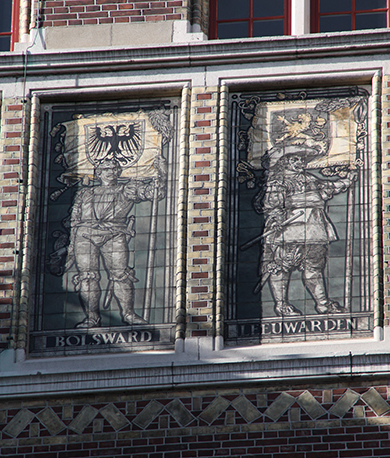
Rijks = Realm's (including the northern cities represented here)
1700-1800
Yes, that eighteenth century... Deep sigh. A century to skip, actually. But then, the poor thing is there. One could pity it, coming after that awesome Number 17, if it weren't for the fact that those hundred years churned out such bad taste.
Hall 1.7
Kind of nice 1, those wall hangings, a kind of precursor of photo wallpaper.
1.11
Kind of nice 2: that burned out castle, after a festive illumination that got out of hand.
Ingenious: a table orrery.
Silver is quite a phenomenon. Often it is either beautiful or over the top and nearly always stunningly valuable. But, put together, in a museum, all those silver objects can appear somewhat tiresome.
We, Dutchmen, are often confronted with the assumption that profit is the guiding principle of our lives. But in a sign of solidarity the English firm Wedgwood happily produced busts of their biggest enemies, such as the Dutch admiral Michiel de Ruyter.
As long as it sells...
1800-1900
1.12
Louis Napoléon Bonaparte carried the title 'King of Holland', but could have run for 'Good Guy' as well.
(As it appears, not combing your hair was en vogue back then too. But maybe that is just what you get after taking off your cocked hat).
It certainly wasn't the idea of his big brother that Louis take the interests of Dutch citizens too much to heart. The painted difference between those two is rather telling.
By the way, Napoleon may have been short for today's standards, his 1,67cm was kind of average in his time.
(As a thought experiment it is surprisingly easy: replacing the head of the emperor in your mind with that of Vladimir Putin).
The Skating Contest provokes nostalgia in us, Dutch people. Those were the days, when freezing winters provided real ice everywhere, allowing to indulge in our beloved skating on the country's lakes and canals. Nowadays, though, when the greenhouse effect sometimes allows us a bit of white, we prove to be not as winterproof as the skating ladies in this painting. They compete with bare arms...
At the time, the public was more shocked by their 'inappropriate' appearance. (Married women were not even allowed to participate).
When is the sculpture of someone really lifelike? In any case when it makes you wonder what he or she is thinking.
The largest painting of the Rijks is The Battle of Waterloo (h 567cm × w 823cm × l 822.7cm !) Most striking: Prince William of Orange (in the forefront on the left), being carried away on a stretcher as 'Hero of Waterloo'. But, actually, his pose is more as if he is making himself comfortable on a divan, far from being in need of an ambulance. Like a soccer player being carried off the field after the most minor of injuries.
That impression proves to be just right, on the scale of battle field injuries that is. He was only shot in the shoulder. But, for sure, just walking off the painting towards the First Aid wouldn't have looked heroic.
Quite refreshing for a change, this David, rather than the familiar:
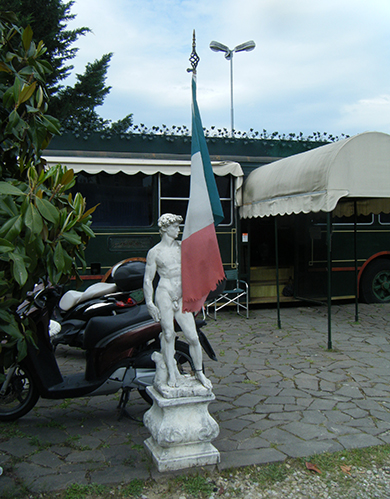
The world's best sold garden gnome
Just to know what to conform to, thanking the emperor: the standard metre.
How does a writer dare, after all that has been written already, to add something to the pile? For that you need to be really special, or ignorant. The same goes for a painter, one would think.
First there was this. Admittedly, its title was made up later. But still, how do you you dare to come up with this afterwards?
1.14
Well, Oberman! Never heard of him. But a tip-top twosome.
Sure, we know Van Speijk all right, the man of the 'fireworks', blowing up his ship (and himself). A Dutch national hero. But baffling are the souvenirs that were crafted out of the debris from that blast, to be sold to Van Speijk-fans. With certificate of authenticity...
1.15
A fitting example of a painting with an especially matching frame. On the painting the first born of the Pharaoh is seen lying there, convincingly recently deceased. Discrete detail in the background: the entrance of Mozes and Aaron. As if, in the midst of a deafening silence, is about to be heard: 'I told you...'
1.17
Although it isn't 'breaking news', it remains incredible: the tiny size of Deshima, the former Dutch trading post in Japan. As we, the Dutch, were happy only to trade with the Japanese, without any missionary zeal, for a ong time we were the only foreigners allowed on Japanese soil. Confined to that micro-plot, that is. For two and a half centuries the Dutch traders were granted to leave their settlement only once a year. For a (compulsory) visit to the authorities in the capital.
From their side, as a Japanese print of the Dutch at dinner clearly shows, they thought we were incredible:
Endless noses! / Sitting on chairs!! / Eating with cutlery!!! / Spitting in pots on the ground!!!!
Weighty symbol of a gnawing dilemma? The seventy carat diamond of the Sultan of Banjarmasin. Once upon a time we took it from him. Should we now give it back?
(Problem: a small girl looking at it next to me, wants it for a necklace)
Facinating: the 'Opium Regie', the Opium State Monopoly in the Dutch East Indies. It clearly demonstrates that the state was already aware of the benefits a long time ago: if you let the state sell narcotics, it both brings in a lot of revenue and guarantees quality at the same time.
On show is an official 'Showcase' with opium samples.
1.18
Funny: The Truncated Windmill.
The other day, by chance, I walked into a painting class, where teacher Bouchaib Dihaj was just embarking upon an anecdote:
'A woman knew for a fact that before cooking fish the head and the tail had to be cut off first. When asked about the reason, she said: 'Just ask my mother'.
Her mother confirmed it had to be done like that. But why? She decided to ask her own mother who happened to be lying on her death bed. Although a rather peculiar question for a moment like that, she dared to come up with it anyhow:
'Mother, why did you always cut off the head and the tail before cooking fish?'
Possibly they were her last words, when the old woman uttered: 'My... pan... was... too small''.
Jan Veth is good up to the point of being ruthless. His father therefore argued that the 'sharp edges' in Jan's portrait of his sisters should have been softened somewhat.
It's the eternal problem for the painter of portraits: the preference of clients for 'paintshopping', tweeking reality.
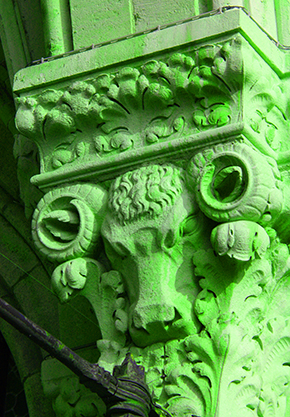
Yes!!! Mauve.
Sometimes it is a pity to know something you didn't know before. The Singel Bridge by Breitner is a heck of a painting, that I knew. But only now I've learned that the lady in the front was a simple maid, originally. Erased for commercial reasons, on request of the art dealer. Hm.
What luxuriance indeed, the Summer Luxuriance by Van Looy. And what a colour splendour! In an effort to pair the exorbitant with the ordinary, in the form of a hay transport.
1900-1950
A line has to be drawn somewhere. So, you think: 'The Rijks collection may just as well halt at the year 1900'. Even though this museum is immense, full is full. And that doesn't mean that their depot of stuff until 1900 is now empty. Besides, for the modern era we have other museums.
The way it is done now in the Rijks, the years 1900-1950 are tucked away in two, separate, attics. That doesn't mean, though, that in these limited spaces there is nothing of value to be found. The announcement is promising enough:
'The 20th Century. The Age of New!'
3.1
It starts off well straight away, with the sculpture of a naked male of Java. On his lap he nurtures... a diesel engine. As if that is, from then on, capable of replacing religious objects for worship.
A fine portrait by Jan Toorop of the chairwoman of an institution I had never heard of before: 'The Association for The Improvement of Women's Clothing', dressed herself in something I was equally unfamiliar with: a 'reform dress'.
Good too: the self portrait by Edgar Fernhout.
Beyond praise: sculptor Hildo Krop.
N.B. Much of his work in public spaces in Amsterdam is hidden from view behind bicycles plumped against it, but in the Museum Shop they have a booklet providing an overview.
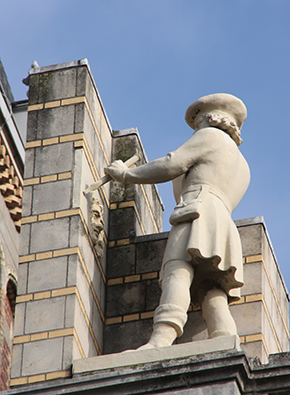
Once, I found myself in the studio of a sculptor in the street where I grew up. I was looking at his work
in the company of painter Carel Willink and his extravagant wife Mathilde, myself unaware of the existence of Willink's Self-portrait as St John the Baptist. Apparently, he didn't see his Mathilde as Salomé, but 'budget threatening' she certainly was. (Because of her outrageous, wildly expensive dresses).
By the way, is 'John the Baptist Willink' lost somewhere near the 'Langkofel'? In any case, it looks rather 'Dolomity' in the distance.
You can't get it much more cynical than that: the Nazi chess set.
This part of this time period ends as a kind of echo of how it began: facial masks of the inhabitants of Nias. Made while they were still alive, you see them as they really were, making you want to ask them posthumously: 'Did you actually want this?'
To get to the next part of this period you have to go on a search trip, via the Front Hall.
3.3
Good drawing by Aat Veldhoen of police scout Jongbloed. What, one wonders, did the motor agent himself think of Aat's work? (Often pretty naughty). It makes you realize that in the whole museum there is hardly any erotic art to be found.
Note:
Some links may not provide images, due to copyright reasons, but are inserted because of the explanatory text.
'I'm Too Sad To Tell You' (that I'm missing) is a video by Bas Jan Ader. Missing since1975.
3.4
Yes, this may be called a museum-level dress.
Fascinating: Relief with Segment by Ad Dekkers.
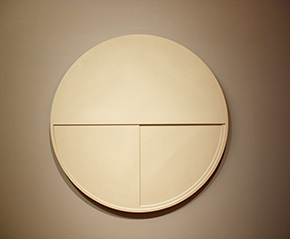
And, finally, Holland's national pride, the Delta Works (better than Hans Brinker), as seen by filmmaker Bert Haanstra. For this, the one single bench they've placed in front of the screen proves to be highly insufficient.
